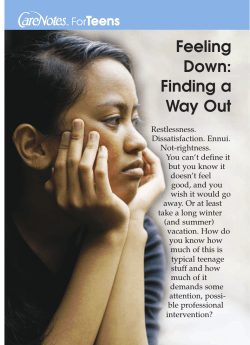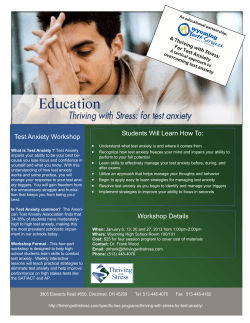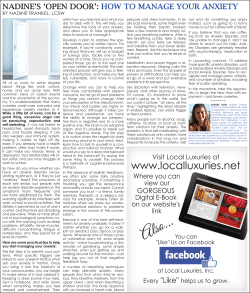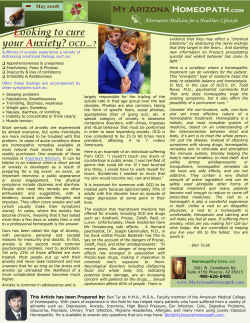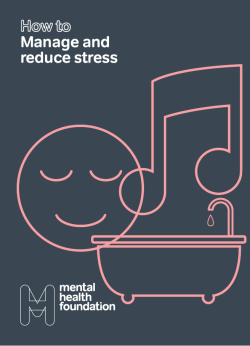
16 Annual ETSU Nurse Practitioner/Physician Assistant Primary Care Conference
16th Annual ETSU Nurse Practitioner/Physician Assistant Primary Care Conference March 27, 2011 , Johnson City, TN Jay M Griffith MD MHC Asst. Chief, Quillen VAMC Clinical Associate Professor, ETSU Dept of Psychiatry and Behavioral Sciences Diplomate, ABPN Psychiatry and Pain Medicine AMYGDALA Drives autonomic and emotional responses HIPPOCAMPUS Evaluates threat contexts PREFRONTAL CORTEX Regulates limbic responses of amygdala and hippocampus PFC HC AMYG Diagram from Bisson 2007 BMJ Content created by Karleyton Evans, MD. Adapted from Rauch, et al. CNS Spectrums. 1998;3(suppl 2):30-34. PFC - DANGER AMYG - HC - Social Phobia 13.3% - Post Traumatic Stress Disorder (PTSD) 7.8% - Generalized Anxiety Disorder (GAD) 5.1% - Panic Disorder 3.5% - 25% Lifetime prevalence for all anxiety disorders - High Comorbidity (depression, other anxiety disorders, substance use disorders) - Generally occur in Females > Males - 1/3 of Americans will experience a panic attack - Serotonin (SE) is most frequently implicated - Norepinephrine (NE) and Dopamine (DA) have roles - Calcium, glutamate, oxytocin, and other neurotransmitter/neuropeptide systems are relevant (eg. Oxytocin Nasal decreases fear responses of social phobics to anxiety provoking social stimuli) 1. 2. 3. 4. 5. 6. 7. Anxiety, fear, avoidance, or increased arousal R/O physiological/medication causes R/O substance induced (caffeine) and obtain UDS Unexpected Panic Attacks: Panic Disorder Fear of humiliation: Social Phobia 6 mos of excessive worry and anxiety: GAD Traumatic event + reexperiencing: PTSD Which of these anxiety disorders can have associated panic attacks? Panic Disorder – basis of the diagnosis Social Phobia – in public situations GAD – during peaks of anxiety PTSD – during heightened arousal A Panic Attack is a discrete period in which there is the sudden onset of intense apprehension, fearfulness, or terror, often associated with feelings of impending doom. During these attacks, symptoms such as shortness of breath, palpitations, chest pain or discomfort, choking or smothering sensations, and fear of "going crazy" or losing control are present. DSMVI-TR The development of emotional or behavioral symptoms in response to an identifiable stressor(s) occurring within 3 months of the onset of the stressor(s). These symptoms or behaviors are clinically significant as evidenced by either of the following: marked distress that is in excess of what would be expected from exposure to the stressor significant impairment in social or occupational (academic) functioning Specify if: Acute: if the disturbance lasts less than 6 months Chronic: if the disturbance lasts for 6 months or longer With Anxiety With Mixed Anxiety and Depressed Mood DSIVM-TR Significant impairment in social or occupational (academic) functioning Panic Disorder – SSRI/SNRI – (use BZP early or late); Cognitive Behavior Therapy (CBT) Social Phobia – SSRI/SNRI, (BZP), CBT; for performance anxiety (B-blocker, Toastmasters International) GAD – SSRI/SNRI , buspirone, (BZP), pregabalin in Europe, CBT PTSD – SSRI/SNRI(SNRIs not for hyperarousal), for nightmares and possibly hyperarousal consider prazosin off label, no BZPs, Exposure-Based CBT It may take 8-12 weeks to see a response CONSIDER OFF-LABEL MIRTAZAPINE FOR ALL DIAGNOSES START LOW AND GO SLOW WITH ALL MEDICATIONS AT ½ THE STANDARD STARTING DOSE FOR SSRIs/SNRIs 5 HT1A partial agonist NE metabolite Begin 7.5mg bid then increase by 5mg q 2-3 days BID or TID Faster increases may produce jitteriness 2-3 weeks before onset A study demonstrated less efficacy for buspirone in those previously treated with a benzodiazepine - No adverse cognitive effects - No physiological dependence - Not cross-tolerant with alcohol - Few side-effects (jitteriness, headache) Middle-aged male with a history of “panic attacks” 3-4 times a month and two phobias. + sexual side effects on SSRIs/SNRIs Consumes 2-3 oz of liquor equivalents nightly and 3-4 oz on some occasions Further history demonstrates he experiences GAD and when panic attacks occur during elevations of GAD intensity 1 month later 10mg tid of buspirone decreases anxiety by 70% 3 months later the patient calls to report increases of all anxiety symptoms He is missing midday doses of medication Change to BID and he’s had sustained benefit - α -1 adrenergic antagonist - Most lipophilic drug in its class (crosses the blood brain barrier) - Previous indications for hypertension (also used off label for benign prostatic hypertrophy) (triple play) - Murray Raskind et al. reported a series of studies into its impact on the re-experiencing of PTSD symptoms, particularly nightmares - Begin at 1mg hs and increase by 1mg/week to 10mg to 12 mg hs in males; 3mg hs in females - Side Effects: First dose syncope and possible priapism; lowers LDL - Efficacious in war-related and civilian PTSD - May also be uptitrated in the AM at < than the HS dose - Addressing hyperarousal/hyperadrenergic c/o First line PTSD treatment in the 2011 Harvard Algorithm (psychopharm.mobi) BENZODIAZEPINES “I’ve been feeling more stressed because ________ happened last week. Can give me something for this?” “I need a nerve pill.” “Yeah, my anxiety is better on the medication (citalopram) but I sure wish you’d give me something for my nerves.” (Longing for the halcyon days). “If you aren’t giving me Valium then I don’t want any of your other medications” (walks out of the office) “I want to make a complaint about one of your doctors who’s committing malpractice” “Cancel my appointment with that doctor…he’s useless” Benzodiazepines, Other Anxiolytic Medications, and Meditations: Selected Topics in Anxiety Management Dispersed across 50 years Many questions are still unanswered including: appropriate indications for and durations of therapy and short and long-term adverse effects There are vast differences of opinion both within the US and between the US and other countries regarding these issues Benzodiazepines, Other Anxiolytic Medications, and Meditations: Selected Topics in Anxiety Management WHAT DO WE KNOW ABOUT BENZODIAZEPINES? From 1969 to 1982 diazepam was the most prescribed medication in America with 2.3 billion tablets sold in 1978 Lader 2011 “In all studies concerning prescription patterns of benzodiazepines, it is noted that scarce information is given on diagnosis and/or indications for benzodiazepine prescriptions on patient charts, in contrast to prescriptions of various other (nonpsychotropic) drugs (Buchsbaum et al. 1986).” “… it was found that initial benzodiazepine prescriptions were given in 35 and 38.5 per cent of cases respectively for other reasons than the recognized indications (van der Waals et al., 1993) (Zisselman et al., 1994).” Writing controlled substances for non-FDA approved reasons “One user in four uses the benzodiazepine for a year or longer.” Balter 1991 “Rates of use increase with age. Persons older than 65 years account for 27% of all benzodiazepine prescriptions and 38% of all benzodiazepine hypnotics.” IMS America 1991 APA Textbook of Psychopharmacology Benzodiazepine studies were 2 months in duration Hypnotic-sedative Anxiolytic Muscle relaxant Anterograde amnesia Antiseizure Enhance GABA effects at the GABA-A receptor producing increased Cl- flux and inhibitory neurotransmission Decrease SE and NE turnover (can generate depression) Dependence involves dopaminergic systems Endozapines are purported endogenous benzodiazepines www.benzo.org. uk Ashton ~ METABOEQUIV LISM DOSE ??????? HALF LIFE ONSET 0.5mg Oxidation 3A4 6-20 Intermediate Negligible (4OH) chlordiazepoxide 10mg Oxidation 3A4 30-100 Intermediate Desmethylchlordiazepoxide clonazepam 0.25mg Oxidation 3A4 18-40 Intermediate 4 amino derivative clorazepate 7.5mg Oxidation (unknown) 30-100 Rapid Desmethyldiazepam (100/200) diazepam 5mg Oxidation 2C19; 3A4 30-100 Rapid (sedation 30 min, peak 1 hour) Desmethyldiazepam (100/200) lorazepam 1mg Glucuronidation 10-20 Intermediate None DRUG alprazolam METABOLITE Half -life (hours) Ranked 11th among all prescriptions in the USA, alprazolam is the #1 psychiatric drug With 46.3 million in 2010, aprazolam prescriptions increased by 3 million/yr since 2006 IMS Health, National Prescription Audit, Dec 2010 TN Top 10 Most Prescribed Controlled Substances 2010 1 Hydrocodone (Lortab, Vicodin) (TN is #2 in the US) 2 Alprazolam (Xanax) – steady for 3 years 3 Oxycodone (OxyContin, Roxicodone, generic) 4 Codeine 5 Clonazepam (Klonopin) – first year in the top ten 6 Zolpidem (Ambien) 7 Lorazepam (Ativan) 8 Diazepam (Valium) 9 Propoxyphene (Darvon, Darvocet) 10 Pregabalin (Lyrica) TN Drug Diversion Task Force 1. Because of its short half-life, alprazolam is associated with behavioral reinforcement and interdose anxiety (“clock watching” ) 2. These phenomena produce elevated anxiety and dose escalations The Alprazolam to Clonazepam Switch Herman et al. 1987 ALPRAZOLAM 1MG TID PRN ANXIETY Develop physiological tolerance while attempting to get control over anxiety Later try taking as a prn Withdrawal and anxiety which will be defined as anxiety or as “panic attacks” Conditioned to rely upon Xanax (anecdote: crying spells with the mention of a minute dose reduction) With long term use there is: Impaired performance on simple repetitive tasks for up to one year and for several years on tests of attention Even after months or years the effects on episodic memory persist Verbal memory is particularly affected May take more than 6 months for the memory effects to completely resolve after stopping Accidents Increased risk of falls in the elderly Increased risk of MVAs Behavior problems- may cause paradoxical excitement in vulnerable groups including: Borderline personality disorder Impulse control diosrder Ongoing alcohol disorders Sleep apnea: Inhibit respiratory response to CO2 and relax upper airway muscles Can worsen sleep apnea or convert snoring into sleep apnea Many authorities, including the FDA, consider benzodiazepines contraindicated in sleep apnea “The niggling question of possible long term anatomical and biochemical changes in the brains of long-term users needs urgent attention to allay mounting concerns in view of the continuing extensive use of BZDs.” GUIDELINES FOR THE USE OF BENZODIAZEPINES IN OFFICE PRACTICE IN THE STATE OF MAINE “There is no evidence supporting the long term use of BZDs for any mental health indication” http://www.benzos.une.edu/resources.htm 1,079,683 medications Benzodiazepines 312,931 Alprazolam 112,552 Clonazepam 57,633 Diazepam 25,150 Lorazepam 36,582 During 2003--2009, death rates increased for all substances except cocaine and heroin. The death rate for prescription drugs increased 84.2%, from 7.3 to 13.4 per 100,000 population. The greatest increase was observed in the death rate from oxycodone (264.6%), followed by alprazolam (233.8%) and methadone (79.2%). By 2009, the number of deaths involving prescription drugs was four times the number involving illicit drugs. Family and Friends Diverted Rx Drugs of Greatest Concern & Sources “Hydrocodone (Lortab, Lorcet, Vicodin and generic equivalents), oxycodone (OxyContin, Roxicodone, and generic equivalents), and alprazolam (Xanax) are the top three most prescribed drugs and primarily are among the most commonly diverted and abused pharmaceuticals in the State of Tennessee. These three drugs prescribed and taken together form what is known to law enforcement as “the cocktail.” TN Drug overdose deaths in Tennessee rose from 422 in 2001 to 1,059 in 2010 This bill, if approved, would require all prescribers and dispensers of schedule II, III, IV or V controlled substances to register in the PMP and check the database regularly All new starts require a database review Reviews could be conducted by licensed healthcare personnell and by one non-licensed person per practice J. Dreyzehner MD TN Commissioner of Health Prescription Substance Abuse Conference, ETSU, 2012 • • • • Addicted Use with other illicit drugs to intensify the intoxicating effects, eg., benzodiazepine + methadone Profit To manage withdrawal symptoms associated with addictions to other drug classes Diazepam (Valium) 5mg $3.00 - $5.00 10mg $4.00 - $5.00 Alprazolam (Xanax) 1mg $2.00 - $4.00 (#120 1mg= $480.00) 2mg $4.00 - $8.00 Early refills, lost medications, patient initiated dose escalations Increasing anxiety Other addictions or misuses of substances, eg., previous alcohol addiction is a relative contraindication Cochrane review recommends 10 week taper Dennis et al 2006 APA Textbook of Psychopharmacology Taper clonazepam and alprazolam no faster than 0.5mg every 2-3 weeks May go even slower in complicated cases with a seizure history Provide clonazepam BID at a TDD at ½ of the of the alprazolam TDD (or at the same dose) 2. Inform patients it takes up to 7 days to make the crossover 3. Throughout the 7 days the patient may take their previous prescription of alprazolam 4. Generally, during the 1-3 days they may need to continue the previous alprazolam prescription 5. Thereafter, they can take the alprazolam less frequently or take ½ of a pill 6. Should be off of the alprazolam at the end of 7 days Individualize depending upon the patient’s medical status, compliance history, and the provider’s availability 1. 1. 2. Data support short term (up to 4-6 weeks) use for acute anxiety and when awaiting the onset of a the first-line agent (SSRI) in the treatment of a primary anxiety disorder Select groups may require maintenance. This requires careful documentation with a risk-benefit analysis and consent, particularly in the elderly or medically infirm 3. 4. 5. Urine drug screens and random pill counts, or the absence of them, should be accounted for in the chart Warning signs of diversion or other forms of misuse require documentation They are contraindicated in any active substance use disorder and relatively contraindicated with any history of substance use disorders, especially in the case of alcohol addiction There is concern that benzodiazepines cause “difficulty integrating the traumatic experience, preventing optimal arousal in prolonged exposure therapy, …” They may decrease the effectiveness of exposure therapies in other anxiety disorders. SSRIs/SNRIs/buspirone/prazosin are not thought to cause such problems. Overwhelming anxiety which blocks adaptation is pathological However, optimal anxiety levels promote adaptation When we venture into treating anxiety, we must be certain that our interventions are promoting adaptation and not hindering it In this way of thinking, treating chronic anxiety with benzodiazepines is not unlike using opioids for chronic pain. Under these circumstances, we must base interventions on measurable changes in functioning and not on subjective reports Significant improvement in social or occupational (academic) functioning MEDITATION AN ADJUNCTIVE AGENT IN THE MANAGEMENT OF ANXIETY The act of utilizing attention to guide changes in brain structure and function Stress Blood pressure Cortisol Pain Anxiety Depression - - Increases attention (the pathway to enhanced memory and intelligence) Bolsters self-efficacy Generates neuroplastic changes in the brain Gray Matter Increases Associated with Meditation Adapted from Holzel et al. 2011 Study Practice Lazar et al. 2005 Pagnoni and Cekic 2007 Hölzel et al. 2008 VestergaardPoulsen et al. 2009 gyrus Luders et al. 2009 Insight 20/15 Zen 13/13 Grant et al. cortex, 2010 cortex Holzel et al. 2011 Insight Meditators/Controls 20/20 Tibetan 10/10 Multiple 22/22 Zen 19/20 Insight 16/17 Brain regions greater in meditators Right anterior insula and right middle and superior frontal sulci Meditators showed no age-related decline in the left putamen compared to actives Left inferior temporal lobe, right insula, and right hippocampus Medulla oblongata, left superior and inferior frontal gyri, anterior lobe the cerebellum and left fusiform Right orbito-frontal cortex, right thalamus, left inferior temporal lobe, right hippocampus Right dorsal anterior, cingulate secondary somatosensory left hippocampus, posterior cingulate, cortex, temporo-parietal junction, cerebellum AMYGDALA drives autonomic and emotional responses MEDITATION/MINDFULNESS HIPPOCAMPUS evaluates threat contexts (safe/unsafe) PREFRONTAL CORTEX Regulates limbic responses of amygdala and hippocampus CONTEMPLATION Diagram from Bisson 2007 BMJ Content created by Karleyton Evans, MD. Adapted from Rauch, et al. CNS Spectrums. 1998;3(suppl 2):30-34. 1. Sit in a quiet area for 20 minutes or more 2. Direct your mind to an object of focus such as your breath, thinking “In” as you breathe in and “Out” as you breathe out 3. When your mind drifts away as it inevitably will, gently direct it back
© Copyright 2025

